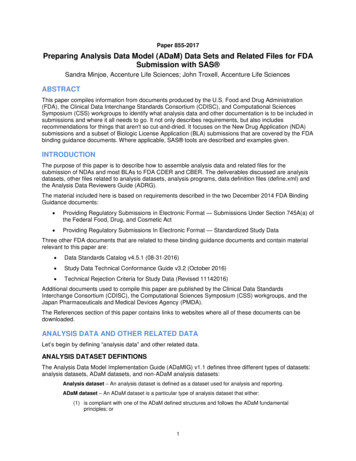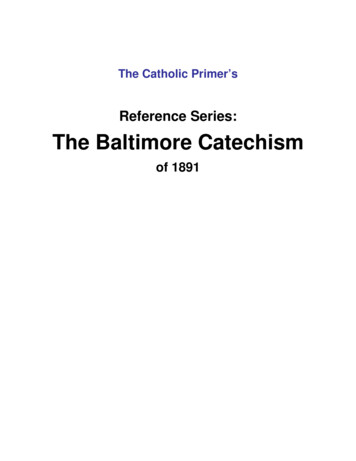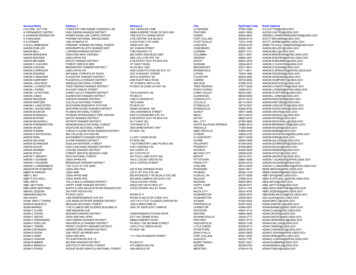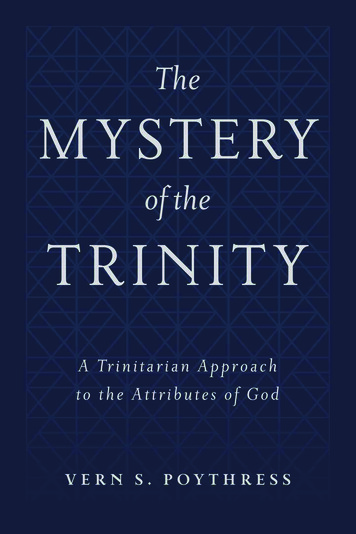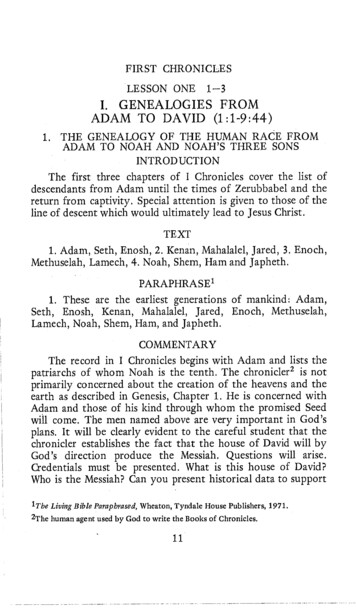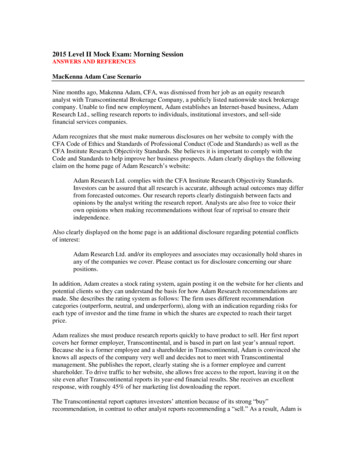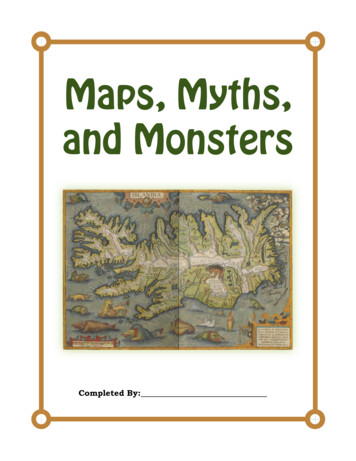
Transcription
Can we still believe in a historical Adam? Vern Poythress offers a theologically and scientificallyinformed evaluation of the claims that genetic analyses show Adam could not have existed.“Poythress boldly and knowledgeably tackles some of the scientific reasoning that has beenused to argue that humans are nothing more than advanced apes. . . . He exemplifies the rightuse of critical thinking in science and in faith.”—C. John Collins, Professor of Old Testament, Covenant Theological Seminary, St. Louis“Most non-scientists don’t know what to make of scientific arguments questioning the historicityof Genesis, and most theologians do not feel competent to evaluate the scientific argumentsor their reliability. Dr. Poythress, who is well informed on the subject, breaks down the mainscientific arguments about human origins in ways accessible to the general reader.”—Ann Gauger, Senior Research Scientist, Biologic Institute, Redmond, WashingtonWritten to equip and strengthen laypeople in their defense of the faith, Christian Answers to HardQuestions challenges contemporary opposition to Christianity with concise, practical answers.Peter A. Lillback and Steven T. Huff, Series EditorsVern S. Poythress (B.S., California Institute of Technology; M.Div. and Th.M., WestminsterTheological Seminary; M.Litt., University of Cambridge; D.Th., Stellenbosch University; Ph.D.,Harvard University) is Professor of New Testament Interpretation at Westminster TheologicalSeminary in Philadelphia.APOLOGETICSISBN: 978-1-59638-917-5EAN504999781596 389175
Did AdamExist?Poythress Did Adam Exist cxs RE printers proofs.indd 13/7/14 3:49 PM
Christian answers to hard questionsChristian Interpretations of Genesis 1Christianity and the Role of PhilosophyCreation, Evolution, and Intelligent DesignDid Adam Exist?How Can I Know for Sure?How Did Evil Come into the World?The Morality of God in the Old TestamentShould You Believe in God?Was Jesus Really Born of a Virgin?Peter A. Lillback and Steven T. Huff, Series EditorsPoythress Did Adam Exist cxs RE printers proofs.indd 23/7/14 3:49 PM
Did AdamExist?Vern S. PoythressPh i la delph i a , Pe n n s y lva n i aPoythress Did Adam Exist cxs RE printers proofs.indd 33/7/14 3:49 PM
2014 by Westminster Theological SeminaryAll rights reserved. No part of this book may be reproduced, stored in a retrievalsystem, or transmitted in any form or by any means—electronic, mechanical, photocopy, recording, or otherwise—except for brief quotations for thepurpose of review or comment, without the prior permission of the publisher,P&R Publishing Company, P.O. Box 817, Phillipsburg, New Jersey 08865–0817.Westminster Seminary Press, LLC, a Pennsylvania limited liability company,is a wholly owned subsidiary of Westminster Theological Seminary.This work is a co-publication of P&R Publishing and Westminster SeminaryPress, LLC.An earlier form of this booklet was published as “Adam versus Claimsfrom Genetics,” Westminster Theological Journal 75, 1 (2013): 65–82. Used bypermission.Scripture quotations are from The Holy Bible, English Standard Version,copyright 2007 by Crossway, a publishing ministry of Good News Publishers. Used by permission. All rights reserved.ISBN: 978-1-59638-917-5 (pbk)ISBN: 978-1-59638-918-2 (ePub)ISBN: 978-1-59638-919-9 (Mobi)Printed in the United States of AmericaLibrary of Congress Cataloging-in-Publication DataPoythress, Vern S.Did Adam exist? / Vern S. Poythress.pages cm. -- (Christian answers to hard questions)Includes bibliographical references.ISBN 978-1-59638-917-5 (pbk.)1. Adam (Biblical figure) 2. Bible and science. I. Title.BS580.A4P69 2013222’.11092--dc232013030936Poythress Did Adam Exist cxs RE printers proofs.indd 43/7/14 3:49 PM
D i d A d am a n d E v e e x i st ? Does science say otherwise? The Human Genome Project has produced voluminousdata about the information contained in human DNA. Variousnews media and scientists tell us that this information demonstrates our ape ancestry. How do we evaluate these claims?We cannot within a short compass examine all the claimsand all the evidence in detail. But we can summarize some of themain points and direct readers to more extensive information.Other works discuss the biblical and theological basis for believing that Adam was a historical person.1 Here we concentrate onthe arguments that depend on appeals to science.99 Percent Common DNAWe may begin with a commonly cited statistic: the 99 percentidentity between human DNA and chimp DNA. In 2005 the CornellUniversity News Service reported, “Chimpanzees and humans sharea common ancestor, and even today 99 percent of the two species’DNA is identical.”2 In 2010 the University of California at San Francisco News Center mentioned the same figure: “The genetic codes ofchimps and humans are 99 percent identical.”3 In 2005 the NationalInstitutes of Health News reported that “our closest living relativesshare perfect identity with 96 percent of our DNA sequence.”4But assessing these claims is more challenging than it mayappear. Note that the NIH report mentions 96 percent instead of99 percent. Why? The same NIH report also includes the figureof 99 percent further on in its description, so none of the figuresis in error. It turns out that the 99 percent figure arises fromusing a number of restrictions: (1) ignore repetitive portions;(2) compare only sequences that can be aligned naturally with5Poythress Did Adam Exist cxs RE printers proofs.indd 53/7/14 3:49 PM
Did Adam Exist?one another; and (3) consider only base-pair substitutions, not“indels” (see below).Befor e we mov e onr What do we discover as we investigate the commonlycited statistic that 99 percent of human and chimp DNAis identical?r What does this discovery tell us about how we shouldreceive even widely reported scientific claims?r How much do you know about DNA? What does thismean for you as you assess information about it?Comparisons of this kind get technical because there can beseveral kinds of correspondence and noncorrespondence betweenDNA strands. Let us lay out briefly some of the issues. At the levelof molecular structure, DNA contains a “code” composed of four“letters,” namely, ACGT (the letters stand for four distinct bases:adenine, cytosine, guanine, and thymine). The DNA code usesa particular sequence of letters, such as ATTGTTCTCGGC, tospecify the exact sequence of amino acids to be used to constructa protein.5 Human DNA and chimp DNA align when one findsthe same sequence of letters in both kinds of DNA:Human: G-C-C-G-A-T-A-A-G-C-A-CChimp: G-C-C-G-A-T-A-A-G-C-A-CA variation is called a substitution when there is a different letterat some one point in the sequence:Human: G-C-C-G-A-T-A-A-G-C-A-C Chimp: G-C-C-G-A-G-A-A-G-C-A-C6Poythress Did Adam Exist cxs RE printers proofs.indd 63/7/14 3:49 PM
Did Adam Exist?(The T does not match the G in the middle of the sequence.)A variation is called an indel (short for insertion/deletion)when one of the sequences has extra letters:Human: G-C-C-G-A-T-G-C-T-G-T-A-A-A-G-C-A-C Chimp: G-C-C-G-A-TA-A-G-C-A-CIf the comparison focuses only on substitutions within alignedprotein-coding regions, the match is 99 percent. Indels constituteroughly a 3 percent difference in addition to the 1 percent for substitutions, leading to the figure of 96 percent offered by the NIH.Befor e we mov e onr What are three kinds of correspondence and noncorrespondence between DNA strands?r How was the 99 percent statistic reached? What aboutthe 96 percent statistic? What is the difference betweensubstitutions and indels?Or LessBut we have only begun. The 96 percent figure deals onlywith DNA regions for which an alignment or partially matchingsequence can be found. It turns out that not all the regions ofhuman DNA align with chimp DNA. A technical article in 2002reported that 28 percent of the total DNA had to be excludedbecause of alignment problems, and that “for 7% of the chimpanzee sequences, no region with similarity could be detectedin the human genome.”6Even when there is alignment, the alignment with otherprimate DNA may be closer than the alignment with chimp7Poythress Did Adam Exist cxs RE printers proofs.indd 73/7/14 3:49 PM
Did Adam Exist?DNA: “For about 23% of our genome, we share no immediategenetic ancestry with our closest living relative, the chimpanzee. This encompasses genes and exons to the same extent asintergenic regions.”7 The study in question analyzed similaritieswith orangutan, gorilla, and rhesus monkey, and found cases inwhich human DNA aligns better with one of these than withchimpanzees.Befor e we mov e onr What new issue have we discovered about the 96 percent “identical” genetic codes? How does this change thesituation?r Does human DNA always align best with chimp DNA?How might this change your attitude to the first statisticgiven?The Challenge of Interpreting DataThe data from the Human Genome Project and similar proj ects for chimpanzees and other animals has to be interpreted. Itdoes not interpret itself. What is the significance of the similarities? Do they in fact show that human beings have ape ancestry?Do they imply that we are little more than naked apes? Do theytell us who we are as human beings?The reigning framework for the interpretation of geneticinformation and biological origin is Darwinism. Darwinism ismuch more than the observation that we can breed dogs or thatwe can study the effects of mutations in fruit flies.8 Darwinismsays that all kinds of living things came into being by purelygradualistic processes. In the popular mind, and indeed alsoamong many scientists, Darwinism also involves the additionalassumption that the process of change over time was unguided8Poythress Did Adam Exist cxs RE printers proofs.indd 83/7/14 3:49 PM
Did Adam Exist?and purposeless—in other words, God, if he exists, is absent.When applied to the question of human origins, Darwinismimplies that we are here by accident, and the kind of race that weare is an accident. Darwinism excludes design by a supernaturalDesigner; it also excludes in principle the idea of a sudden originof a new kind of living thing through direct creation from nonliving material, or through multiple simultaneous mutations,or through large-scale reorganization of living cells, or throughany other kind of event that could realistically have taken placeonly through the presence of a Designer.We must take into account the influence of Darwinism as aframework, because the framework guides how people interpretthe significance of genetic similarities. The similarities exist—ofthat there is no doubt. But what do they mean?Befor e we mov e onr Scientific data does not interpret itself. What would happen if it did? What happens because it does not?r What does the author mean by calling Darwinism aframework?r On the most basic level, what does Darwinism say aboutliving creatures? What do many people assume that Darwinism also says? What does this brand of Darwinismexclude?No Purpose?First, we should distinguish two issues: the issue of purposeand the issue of gradual processes. They are distinct. Accordingto the teaching of the Bible, God is continually involved in rulingthe world providentially. He is intimately involved in regular,gradual processes; his presence is not confined to miracles or9Poythress Did Adam Exist cxs RE printers proofs.indd 93/7/14 3:49 PM
Did Adam Exist?exceptions. The following verses in the Bible illustrate God’sinvolvement:You [God] make springs gush forth in the valleys.(Ps. 104:10)You cause the grass to grow for the livestockand plants for man to cultivate. (Ps. 104:14)You make darkness, and it is night. (Ps. 104:20)When you send forth your Spirit, they [the next generationof animals] are created,and you renew the face of the ground. (Ps. 104:30)In particular, God is active in the formation of human life in amother’s womb:For you formed my inward parts;you knitted me together in my mother’s womb. (Ps. 139:13)God is active as the Primary Cause in addition to the secondarycauses that are involved in springwater, the growth of grass, thecoming of darkness, the birth of animals, and the gestation andbirth of human beings. God has purposes in all these events.Within the picture presented in the Bible, scientific analysisof the secondary causes describes how God brings about hispurposes—he does so through gradual processes.Now, for the sake of argument, let us suppose that the mainstream picture of gradualism is true; that is, purely gradualprocesses produced all living things. That picture is completelycompatible with God’s having done it all for his own purposes.9When Darwinism says that the process is “purposeless,” it might10Poythress Did Adam Exist cxs RE printers proofs.indd 103/7/14 3:49 PM
Did Adam Exist?mean merely that scientific research, narrowly conceived, is notcompetent to discern the purposes, but only the processes. Butin the popular mind, Darwinism is much more: it implies thatthe purposelessness of the process is definitively established.And that claim overreaches the evidence and the competence ofscience. It is really a philosophical and religious claim. It makessense only if a person already knows or believes that God doesnot exist or that he cannot have purposes that he is accomplishing in gradual processes. The belief is simply smuggled in; it isnot an inference just from raw data.Moreover, the belief about absence of purpose has the potentialfor feeding back into scientific investigation and influencing scientific interpretation. If there is no God or no purpose, gradualism isvirtually the only option, and adherents may cling to it uncritically.10Befor e we mov e onr In what ways does the Bible describe God’s involvementwith the world? If God is the Primary Cause, why andhow do secondary causes work?r How would we know whether something were purposeless? If we believe in purposelessness, what options dowe have?GradualismNow consider the second issue, the issue of gradualism.According to the picture in the Bible, God can work as he wishes.Many times he works through gradual processes, as we haveobserved. The regularity of these processes reflects God’s faithfulness. But he is not a prisoner within these processes. Hisrule over the world is what establishes the processes in the firstplace.11 He is free to work exceptionally, whenever he wishes. The11Poythress Did Adam Exist cxs RE printers proofs.indd 113/7/14 3:49 PM
Did Adam Exist?experimental aspect of science is possible because of the regularities in God’s rule. But rightly understood, science is subjectto God and cannot presume to dictate to him what he has to do.It cannot forbid exceptions. Thus, exceptions are possible in thecase of one-time, unrepeatable events, such as the origin of theuniverse, the origin of the first life, and the origin of humanbeings. The gradual processes that represent the usual meansfor God’s rule may have exceptions.Befor e we mov e onr How does God’s rule over the world make science possible?r What does it mean to say that God can and does work“exceptionally”? What is the relationship between scienceand God’s exceptional work?It has now become customary for mainstream representativesof Darwinism to say that the discussion of possible exceptions isa matter not of science but of religion. Of course, it depends onhow one defines science. But it also depends on how one definesreligion. If Darwinism says that the events involving the originsof living things are purposeless, it is making a quasi-religiousclaim about the lack of God’s involvement. If it says that there areno exceptions to gradualism, it is also presuming that it knowsbeforehand how God will interact with life, and that, too, is areligious claim. Atheism is a “religion” in this sense because itmakes a claim about God, namely, that he does not exist. AndDarwinism is a “religion” in this sense because it makes claimsabout the involvement of God.The important feature here is that within the mainstreamof modern culture, Darwinism is not seen as religious, but asmerely “neutral” and “scientific.” Why? Because the religiousassumptions have already been incorporated into the “scien12Poythress Did Adam Exist cxs RE printers proofs.indd 123/7/14 3:49 PM
Did Adam Exist?tific” theory in the form of underlying assumptions about lackof purpose and gradualism. We are simply told that “this is howscience is done.”12 Because of the cultural prestige of science andscientists, many people simply accept the present state of thingsas if it were the only possibility. But once we question the underlying assumptions, it becomes clear that there are other possibleways of construing the meaning of science: science studies theregularities of God’s providential rule, and can do so withoutmaking assumptions that ban the idea of divine purposes orban God’s exceptional acts.Befor e we mov e onr Over the years, how has science come to be defined?r What assumptions are included in this definition? Arethose assumptions religious, scientific, or both?r Is this the only way we must view science? What otherperspectives might we take?Interpreting the EvidenceNow we can return to consider the similarities betweenhuman DNA and chimp DNA. What is the meaning of this evidence? It depends on the framework that we have for interpretingthe evidence. If our framework is Darwinism, with its purposelessness and gradualism, clearly the similarities confirm thestandard picture of gradualism. We postulate a gradual seriesof mutations by which a common pool of ancestors graduallyseparated into protohuman and protochimp lines. The evidenceconfirms the framework because we already have the framework.If, on the other hand, we use a framework in which God haspurposes, he may act either gradually or exceptionally. Whichever means he uses, the DNA is fundamentally his design. The13Poythress Did Adam Exist cxs RE printers proofs.indd 133/7/14 3:49 PM
Did Adam Exist?similarities are the product of his intelligent design. Both thesimilarities and the differences have purposes in the mind of God(though we ought not to presume to claim detailed knowledgeabout all his purposes). They testify to his wisdom, whether hebrought about the present situation by gradual processes or byone or more exceptional acts. We cannot presume to say justhow he did it without looking both at the data and at whateverwe have come to know about God.Befor e we mov e onr What are two fundamental components of Darwinism?How are these components applied to interpreting similarities in DNA?r What are two aspects of a framework that takes God intoaccount? How can these aspects be applied to interpretingsimilarities in DNA? Using this framework, what can wenot presume?The most striking genetic similarities between humans andchimps lie in many of the protein-coding regions within the DNA.That is understandable from the standpoint of design becauseproteins are the backbone of chemical machinery inside a cell.Cells have to have machinery for metabolism, for cell division,for translating DNA into proteins, for dealing with toxins, and forresponding to the environment. The machinery has to accomplishmany of the same things in cells of many kinds, so it should notbe surprising that there are similarities among proteins not onlybetween man and chimpanzee but throughout the world of livingthings. God may have brought about these marvelous similaritiesthrough gradual processes, if he so chose, but it is up to him.13Given the prevailing Darwinist framework, it is natural thatmedia reports would concentrate on the striking similarities in14Poythress Did Adam Exist cxs RE printers proofs.indd 143/7/14 3:49 PM
Did Adam Exist?protein-coding regions because these allegedly confirm the Darwinian framework. In popular reports, difficulties arising fromdissimilarities in other regions of DNA are left in silence, withthe expectation that these will be explained by the same framework sometime in the future. Without any malicious intent, theevidence is naturally selected to put in the forefront the “confirming” evidence rather than evidence that is still problematic.But before ordinary people are bowled over by the claims, theyshould ask themselves whether the claims are colored by theassumptions of the framework.14Befor e we mov e onr From a design point of view, what is understandable andnot surprising about the similarities in the DNA of different living creatures?r From a Darwinist point of view, what is not surprisingabout the similarities in the DNA? In this view, how are thedissimilarities received and understood? Is there anythingmalicious about this?Does it make sense that God would create human beings withso much similarity to animals? It is up to God how he wants todo it. If he wants to make similarities, he can do so—howevermany similarities he wants. We have to investigate, not presumebeforehand to know how he would do it.The Bible does not offer details about chemical compositionor other technical matters about the human body. God had theBible written for all of us, to tell us about himself and about whatis important for our practical living, not to overwhelm us withtechnical details that many people would not understand. But it isinteresting that the Bible does give hints concerning similaritiesbetween human beings and the animal world. Genesis 2:7 says15Poythress Did Adam Exist cxs RE printers proofs.indd 153/7/14 3:49 PM
Did Adam Exist?that when God made man, “the man became a living creature.”The expression “living creature” is the same as the expressionused in Genesis 1:20, 21, and 24 to describe animals. Man is created from “dust from the ground” (2:7), which also hints at thecommon material stuff making up his body. Man made in theimage of God is supreme over the animals (1:28), but he also hasa definite solidarity with them. The language about “the imageof God” underlines human uniqueness, but even here there is asubordinate similarity. The Bible indicates that Adam fathereda son “after his image” (Gen. 5:3). This imaging process throughfathering has analogies to animal reproduction, such as evenancient people could observe. The common pattern of fatheringderives by analogy from God, who is God the Father in relationto his divine Son.15 This divine original pattern is reflected inan analogical fashion in all the patterns of similarity that wesee among living things.Befor e we mov e onr Does it make sense for God to create human beings in away similar to animals? In what ways does the Bible suggest that he has done this?r What is the purpose of the Bible? Do technical scientificdetails fit with this purpose?Miracles and SolidarityWe can illustrate the principle of solidarity in other kindsof cases. John 2:1–11 describes a miracle in which Jesus turnedwater into wine. If a scientist had been there to test the product,would the wine have tasted, smelled, and looked like ordinarywine? Would its chemical composition have been the same aswine? We do not know the details, but it is certainly a reasonable16Poythress Did Adam Exist cxs RE printers proofs.indd 163/7/14 3:49 PM
Did Adam Exist?possibility that God would choose to work a miracle in such away that the product would fit naturally into the world that hehad already made.Matthew 1:18–25 and Luke 1:34–37 indicate that Jesus wasborn of a virgin. If a scientist had been able to test a sample ofDNA from Jesus’ cells, would he have found a normal humanY chromosome, such as is present in the human DNA of menbut not women? The Bible does not speak directly about suchdetails, but Hebrews 2:14, 17; 4:15, and other passages indicatethat Jesus was fully human. (Other passages, of course, indicatethat he is also fully divine. He is one person with two natures,a divine nature and a human nature. This is a great mystery.) Itis reasonable to infer that Jesus’ full humanity extended even tosuch details as the Y chromosome. If so, the Y chromosome is anexample of a thoroughgoing DNA match that was not the productof ordinary mammalian reproductive processes. The match is aproduct of a miracle, and it has a clear divine purpose—namely,that Jesus should be fully human, in solidarity with the rest ofhumanity, so that he may represent us as our Sin-Bearer andHigh Priest: “Therefore he had to be made like his brothers inevery respect, so that he might become a merciful and faithfulhigh priest in the service of God, to make propitiation for thesins of the people” (Heb. 2:17).(Of course, some people may reject water becoming wineand the virgin birth because they reject miracles in principle.But that is another issue. If God is God, he can work miracleswhen he chooses.)Jesus’ virgin birth is clearly a most exceptional case, butit shows that we must reckon with more than one possibleaccount for DNA matches. The solidarity of human beings withanimals and with primates belongs to a different order fromsolidarity within the human race, but the broad principle of17Poythress Did Adam Exist cxs RE printers proofs.indd 173/7/14 3:49 PM
Did Adam Exist?solidarity remains.16 John Bloom perceptively asks, “Does manhave to be different to be proof that God made him directly?”The answer is no.17Befor e we mov e onr What is the principle of solidarity? How does it apply to themiraculous, exceptional work of God? How does it applyto the relationship between humans and animals?r Why do human beings not have to be different from animals in order to prove that God created them directly?Do Percentages Matter?Now, for the sake of argument, suppose that human DNA hadmatched chimp DNA in 99 percent of the cases all along the DNAstrands, not merely in cases of single-base substitutions in alignedregions. What would that prove? Within a Darwinian framework,it might suggest that human beings are merely one more primate.But if God exists and is interested in human beings—if indeed hecreated human beings uniquely in his image, as the Bible indicates(Gen. 1:26–27)—the essential character of human nature is not tobe found in quantitative comparisons in the chemistry of DNA. Amerely quantitative approach to human nature is part and parcelof a materialistic worldview, in which virtually everything reducesin the end to matter and motion. On the other hand, if personsare significant because God made them, it matters little whattheir exact chemical makeup is. What matters is that they arepersons who can relate to God, who is personal. The frameworkfor interpretation is different, and that framework leads to a different assessment of the significance of humanity. The question ofgenetic similarity remains of interest to scientists, but it is entirelysecondary to the question of human significance.1818Poythress Did Adam Exist cxs RE printers proofs.indd 183/7/14 3:49 PM
Did Adam Exist?Befor e we mov e onr How is Darwinism forced to take a “merely quantitativeapproach to human nature”? What does this mean? Is thisproblematic?r How does a design framework change the whole perspective brought to DNA evidence? Is the design frameworkdismissive of the evidence? Why, or why not?r Can Darwinism say anything about the significance ofhumanity? Can design? Why?Junk DNAAbout 1.2 percent of human DNA has code that is translated into proteins.19 What about all the rest? When geneticistsbecame aware of noncoding DNA, the Darwinist frameworkprovided an explanation. Noncoding DNA was interpreted asgiving us a record of broken evolutionary pieces that no longerhad a function—it was “junk” DNA.20 Francis Collins pointedto this “junk” as one evidence for the gradualistic character ofhuman genetic origins.21But further research has uncovered many positive functionsin what was formerly termed “junk.” The ENCODE project (the“Encyclopedia of DNA Elements”) has endeavored to cataloguesystematically the noncoding DNA, and reports that more than80 percent has “now been assigned at least one biochemical function.”22 The leader of the ENCODE project accordingly called forretiring the word junk.23Befor e we mov e onr How was noncoding DNA once interpreted? Why did thisview change?r What does this show us about interpretative frameworks?19Poythress Did Adam Exist cxs RE printers proofs.indd 193/7/14 3:49 PM
Did Adam Exist?The Function of the FrameworkIs Darwinism in trouble? In one sense, no, because Darwinism has become a flexible framework. Is 98 percent of thegenome alleged to be nonfunctional? No problem, becauseit confirms that Darwinian evolution is messy. Is at least80 percent of it functional? No problem, because it confirmshow efficient natural selection, mutations, and DNA rearrangements are in producing superb fitness and complexfunctionality.Many kinds of evidence can be plausibly fit into the Darwinian framework, because the framework itself has evolved overa hundred years to provide space to accommodate evidence.24The pervasiveness of the framework makes it difficult for peopleto stand back far enough to ask crucial questions.25 Should weexercise skepticism about reigning assumptions? Should we askwhether the framework as a whole needs questioning? A fewpeople see problems. Nobel Prize winner Robert B. Laughlincomplains,Most important of all, however, the presence of such corollaries [from mass behavior in solid-state physics] raises theconcern that much of present-day biological knowledge isideological. A key symptom of ideological thinking is theexplanation that has no implications and cannot be tested.I call such logical dead ends antitheories because they haveexactly the opposite effect of real theories: they stop thinking rather than stimulate it. Evolution by natural selection,for instance, which Charles Darwin originally conceived asa great theory, has lately come to function more as an antitheory, called upon to cover up embarrassing experimentalshortcomings and legitimize findings that are at best questionable and
Did Adam Exist? How Can I Know for Sure? How Did Evil Come into the World? The Morality of God in the Old Testament Should You Believe in God? Was Jesus Really Born of a Virgin? Peter A. Lillback and Steven T. Huff, Series Editors Poythress_Did Adam Exist_cxs_RE printers proofs.indd 2 3/7/14 3:49 PM
